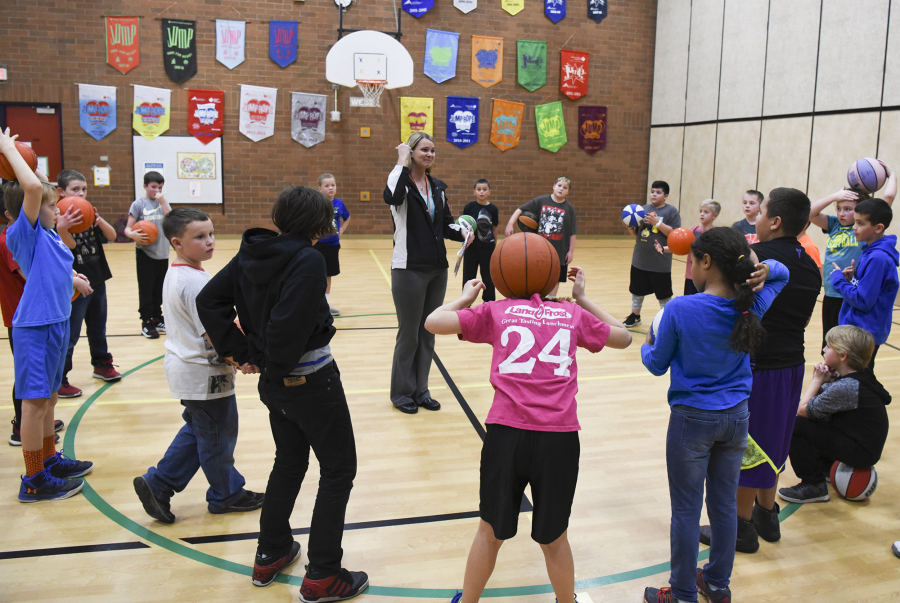The once-quiet after-school hours at Burnt Bridge Creek Elementary School were a flurry of activity on a recent fall afternoon, as students played basketball in the gym and crocheted scarves in the library.
“It’s really, really bright,” acknowledged 10-year-old Wyatt Bird as he stitches a yellow scarf he’s planning to give as a gift.
“Then you get to see someone wear it and see that you did it,” Wyatt said.
These after-school activities are a new feature at the east Vancouver school, where Evergreen Public Schools officials are encouraging teachers districtwide to eliminate traditional homework — worksheets and after-school projects — and replace it with more fulfilling experiences. Teachers can assign homework, but are prohibited from punishing students for not completing it. Instead, students are encouraged to read every day, or, as is the case at Burnt Bridge Creek, attend one of the clubs started this year.
The policy, which the district has been rolling out in recent years, is based on growing evidence showing that homework does not cement student learning.
“There’s a body of research that suggests homework … is an ineffective exercise,” said Scott Munro, the district’s director of elementary education.
Homework could even be harmful to some students, adding stress and frustration for students who may not have a parent at home to help, or who may not even have a home or safe place to do their homework at all.
“They can be struggling with it,” Munro said.
No-homework policies are becoming increasingly popular across the country, and one was even the subject of a viral Facebook meme earlier this year. Brandy Young, a second-grade teacher at Godley Elementary School in Godley, Texas, sent her students home with a letter telling parents there would be no “formally assigned homework this year.”
“I ask that you spend your evenings doing things that are proven to correlate with student success,” Young wrote, according to a photo of the letter a parent posted in August. “Eat dinner as a family, read together, play outside and get your child to bed early.”
As of late December, the post had been shared more than 72,000 times.
Denise Pope is a senior lecturer and founder of the Challenge Success program at the Stanford University School of Education. Pope, who has researched the effects of homework, was not surprised when Young’s letter went viral, and said that it resulted in a flurry of interest in research on homework.
“You never know why something gets picked up at the time it gets picked up,” Pope said.
Pope co-authored a study published in the Journal of Experimental Education in 2014, which, according to a Stanford news release, found that in a study of 4,317 students in affluent California communities, 56 percent of students considered homework a primary source of stress, saw their health decline and spent less time with loved ones and on extracurricular activities.
But alternatives, such as Burnt Bridge Creek Elementary School’s clubs, can replace that stress with student learning.
“They expose them to things they may never try,” Pope said. “It shows you that you can learn something new and take on a challenge.”
Donna Beegle, president of Portland consulting firm Communication Across Barriers, has worked with Evergreen Public Schools and Vancouver Public Schools to help the districts consider the way they assign homework. Beegle, who has researched the effects of homework on children living in poverty or facing other risk factors, said schools are often demanding too much of students who may not have food or safe shelter when they assign homework.
Of the district’s 26,139 students, 47 percent receive free or reduced-price meals, the most standard identifier of low-income families in schools. Burnt Bridge Creek Elementary School’s rate is on par with the district, with 47.6 percent of the school’s 456 students qualifying for free or reduced-price meals.
“We keep asking people in crisis to act middle class, and when they don’t, we punish them,” she said.
Beegle praised Evergreen’s efforts to replace homework with clubs, saying they’re giving opportunities to students who may otherwise never be able to afford to go to camp or participate in other after-school activities.
“We are removing the poverty obstacles and giving families and children the luxury to learn,” she said.
Librarian Kari Oosterveen watched as students stitched their way through scarves. Across the library, she hosts an arts and crafts hour. Her students recently made colorful batik fabrics, which were hung to dry.
Oosterveen said she has been “thrilled” with the introduction of clubs, saying they expose children to something they may never get to experience.
“It’s not the stuff you’re going to be doing in the classroom,” she said. “We need more things for kids to do that are productive.”




